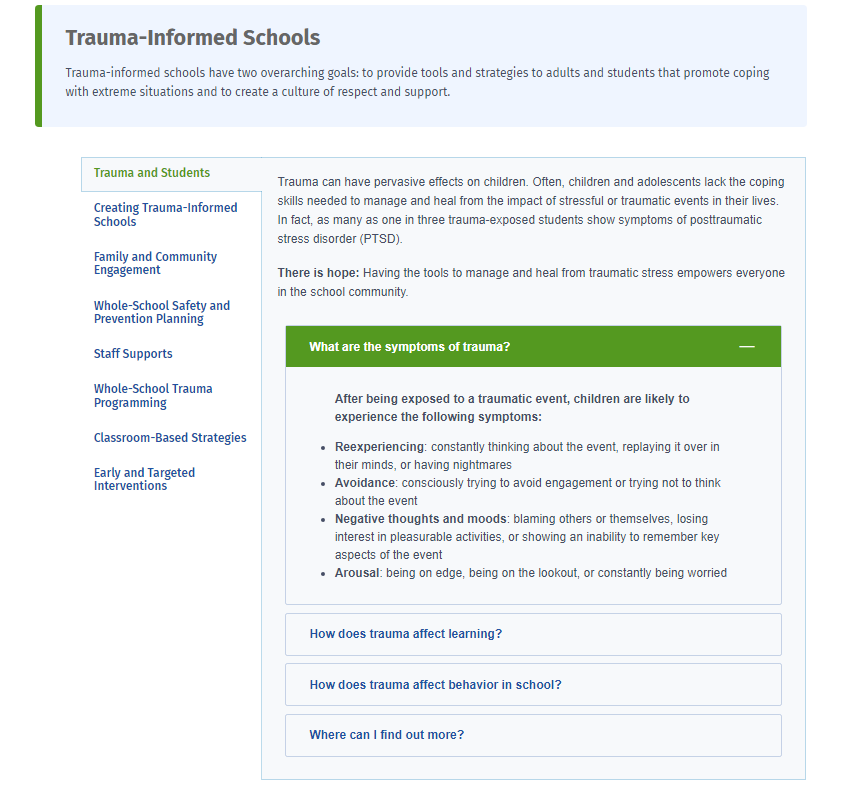Trauma Aware Schools
As students and school staff go through their days, the effects of trauma are all too visible. From cognitive delays to teacher burnout, trauma has the potential to touch nearly every aspect of the school experience. In a 2007 study, researchers found that more than two-thirds of children have experienced at least one traumatic event, which can profoundly affect their ability to effectively engage in learning. “Despite what we know about the disruptive and distressing symptoms of PTSD, depression, and anxiety, we are not fully meeting the needs of children who suffer from the negative consequences of exposure to trauma,” writes Dr. Marleen Wong, a pioneering developer of interventions for children’s trauma in schools.
Over the past decade, 3C Institute has met Dr. Wong’s call to action by partnering with the RAND Corporation, the Center for Resiliency, Hope, and Wellness in Schools, and the Center for Safe and Resilient Schools and Workplaces to disseminate a wide offering of trauma-related interventions.
This April, our partnership took another leap forward with the launch of a redesigned joint website for both centers that serves as a central hub for caregivers, educators, and mental health professionals searching for evidence-based interventions for trauma. (Although each center retains its own distinct identity, in this article we will refer to them collectively as “the Center.”) The variety of programs featured sets the site apart from other resources.
We are not fully meeting the needs of children who suffer from the negative consequences of exposure to trauma.
Marleen Wong, PhD, Director and Principal Investigator of the Center for Resiliency, Hope, and Wellness in Schools
A New Site, A New Era
The update offers more than a new look. Drawing on 3C’s custom behavioral health technology, TraumaAwareSchools.org brings together:
- A visually compelling website
- A richly stocked resource center
- A suite of evidence-based trauma interventions
These tools enable teachers, administrators, staff members, mental health providers, and students to build a trauma-informed school culture.
Putting the Informed in Trauma-Informed
Understanding the scope and effects of trauma is the first step toward building a supportive school culture. To encourage schools to adopt this approach, the Center provides a convenient guide on its Home page for creating a trauma-informed school. Each tab in the guide details a key component of a trauma-informed school, making it easy for school staff to begin incorporating these components in their own schools.
The components include:
- Family and community engagement
- Whole-school safety planning and engagement
- Staff supports
- Whole-school trauma programming
- Classroom-based strategies
- Early and targeted interventions
These components, as former Cognitive Behavioral Intervention for Trauma in Schools (CBITS) trainer Joshua Kaufman suggests, help change attitudes throughout the entire school system. “Ultimately,” Kaufman says, “trauma-informed schools understand and recognize that children’s behavior is a developmental response to past experiences.”
The new website supplements the information provided in the guide with a redesigned and streamlined resource center that groups resources according to intended audience, relevant interventions, and file type. Most importantly, it lets visitors filter and search for the topics that most interest them.
Ultimately, trauma-informed schools understand and recognize that children's behavior is a developmental response to past experiences.
Joshua Kaufman, former CBITS trainer
Interventions
Six interventions form the backbone of the Center’s efforts to build resilience and coping skills in schools. True to the Center’s mission to “provide equitable and inclusive care,” the interventions collectively address the needs of students, teachers, and school staff members.
Student interventions currently available:
- A completely redesigned Cognitive Behavioral Intervention for Trauma in Schools (CBITS)
- Bounce Back
- Support for Students Exposed to Trauma (SSET)
- Life Improvement for Teens (LIFT)
Staff trainings currently available:
In response to recent events, including those highlighted by the Black Lives Matter protest during and after the summer of 2020 and recent school shootings, the Center is redoubling its efforts to provide crisis training in schools.
Two crisis-related programs are coming soon:
- The Racial Trauma Module, offered as a live training
- Psychological First Aid-TEACH
A Suite of Tools
Pamela Vona, cofounder of the Center for Safe and Resilient Schools and Workplaces and program manager for the Center for Resiliency, Hope, and Wellness in Schools, explains that trauma awareness is a process, not a checkbox. “Being a trauma-informed school isn’t doing just one thing,” she notes, adding “it involves engaging in a variety of practices to effectively support the needs of students and staff.” The website, interventions, and resources form a powerful suite of tools for anyone interested in taking the first step in this process.



